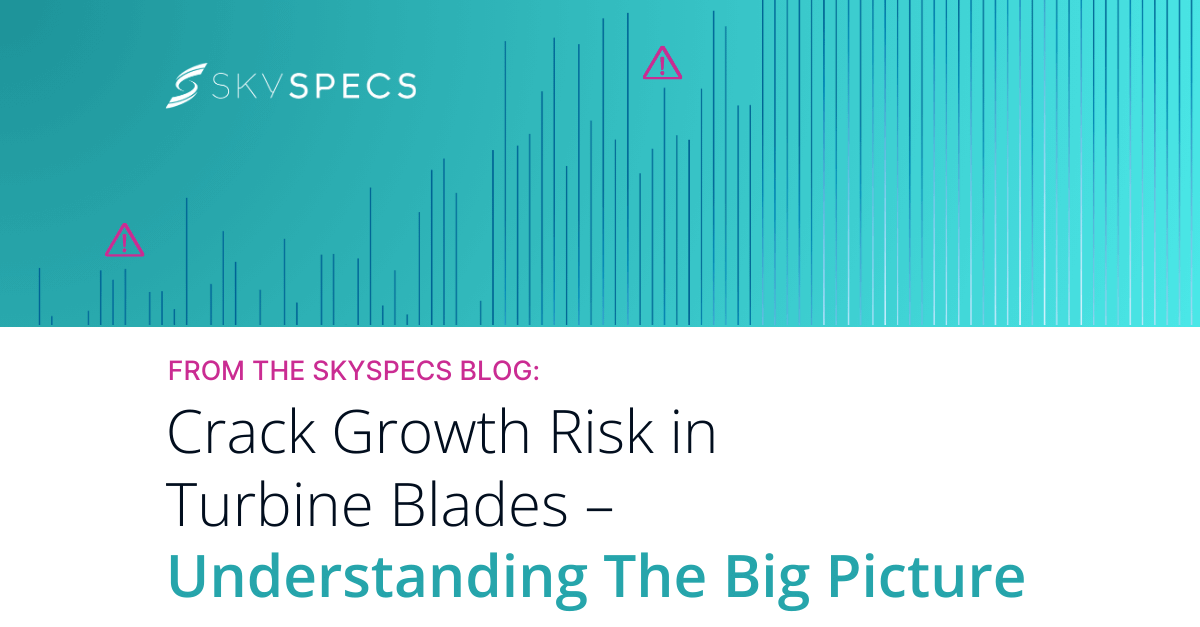Wind turbine blades suffer damage from operation, poor maintenance, age, and more. However, a specific type of damage has consistently been a major cause of blade failures.
In a recent webinar, Tomasz Sieradzan, Principal Engineer at SkySpecs, discussed the findings of a study SkySpecs conducted on managing the risk of crack formation and propagation on wind turbine blades.
What the study focused on
Wind turbine blades face many risks that can cause damage, loss of effectiveness, or even tower failure in some cases. Blade damages can lead to significant disruptions, which can prove very costly for repairs and business disruption.
The types of risks facing the wind industry include systemic issues, such as design flaws and manufacturing defects. There are also weather elements such as lightning strikes, ice, and sudden wind events that could speed up erosion and blade damage – all of which can be hard to predict and avoid.
In today’s industry, the rising trend is more giant turbine blades to increase output. The problem is that larger blades mean heavier structural loads, with more challenges and costs associated with repairing and transporting the blades if they need replacing.
OEMs are under pressure to design larger turbine blades to increase output, but balancing efficient and robust design with costs and risk management becomes more challenging.
Data shows that the common trend within the industry is to inspect blades every second year, but is that enough to help mitigate risk? SkySpecs conducted a study on cracks in turbine blades to answer that question, as this type of damage is most commonly associated with blade failure and major repairs.
From an operational perspective, we decided to aggregate the blades over three parameters, these were:
- Rotor blade size: small (<40m), medium (40-55m), large (>55m)
- Age of assets
- Geographical location: 4 U.S. Regions (North-Central, South-Central, West, North-East) and Europe
For the study, around 65,000 damages were taken into account from over 137,000 inspections. We examined multiple crack risk categories and focused on medium, high, and very high-risk levels.
Medium-risk cracks constitute a group of constrained damages that we typically advise should be repaired in the current season, but they often aren’t addressed until the following year. High-risk cracks are recommended to be repaired as soon as possible, and very high-risk ones often require turbine shutdown due to the size of the damage and the risk of rapid propagation if operated.
What we need to consider when conducting blade inspections
When analyzing cracks in turbine blades, there are two important aspects – crack formation and crack propagation. Studies into blade risks associated with cracks can’t be conclusive without considering these two aspects.
Our research first considered the formation rates for cracks across asset age. We found that our research reflected clear trends across certain blade sizes. The first forming rate peak varies across blade models and can be seen sooner in the largest blades. Noticeably, the absolute risks vary significantly across blade sizes, making new-generation blades more fragile assets.
Another aspect we looked at is quantifying the probability of crack propagation. This involves the likelihood of risk level increases over a specific period. We looked at multiple scenarios of risk advancements over one year, two years, and beyond. Using crack’s propagation probability over different sampling cadences, we measured the odds of risk increase between 1 year and two years of operation.
Quantifying relative risk levels across operational timeframes is a breakthrough in the field. This allows us to prepare for upcoming challenges and confidently plan budgets and repair scopes.
Another finding we noticed in our research is that the size of the rotors can help us predict when faults may occur. For small rotors, the probability of damage growing is around 10% for a 2-year operational timeframe. The same consideration for large rotors results in an estimated probability of over 40%.
How to manage risk with blade inspections
Blade inspections are often a balancing act between timing the inspection and the scope of necessary repairs within the available weather window. There are three main things to consider when managing risk through blade inspections:- Repair prioritization
Consider which damages get addressed first and whether there’s any flexibility or schedule to work around with the repair crew. Larger cracks in blades will need more urgent repairs to reduce the risk of failure, so it’s important to categorize the level of damage and prioritize which repairs are needed first, accounting for the probability of rapid propagation.
- Budget and planning
Of the repair damages that will roll into next year, how does the current budget look? What are the chances of damages growing and their impact on budgetary planning? It can be hard to predict what damages might occur in the year ahead, but you can reduce the risk of missing them with regular inspections and prioritizing repairs of the assets at the highest risk first.
- Blade size
One of the top industry trends today is that turbine blades are getting bigger and bigger to maximize output.However, bigger blades are more susceptible to damage, such as cracks. Our research found that the crack formation and progression probability is much higher for large and extra-large blades than smaller, 10+ old assets. This means that they require more upkeep, cost more to maintain, and may require more frequent inspections.
If the wind farm you manage has a high proportion of large blade models, it may be time to adjust your inspection schedule to account for more frequent checks of these models.
This is an adjustment many in the industry must make as O&M teams start to manage bigger and bigger turbines.
Do you have specific questions about managing the risk of crack formation and propagation on wind turbine blades? We’re here to help!



